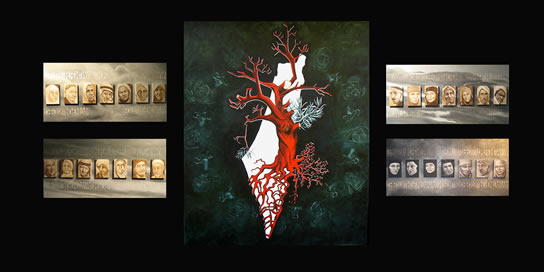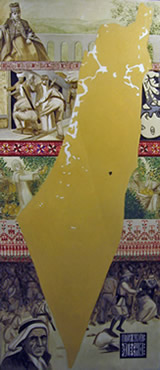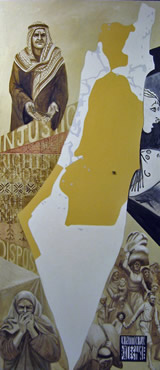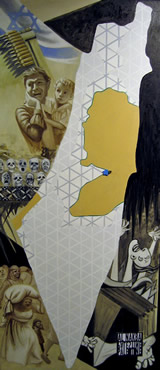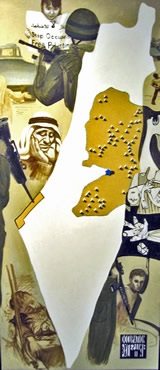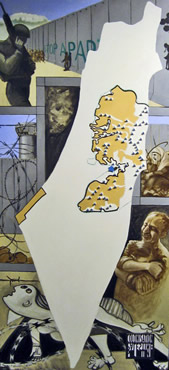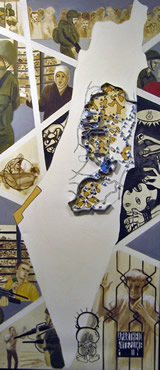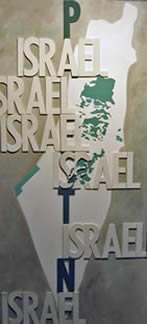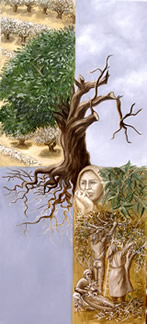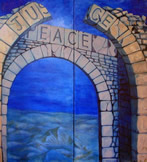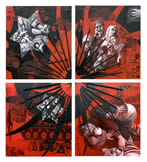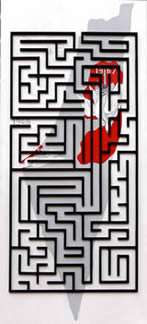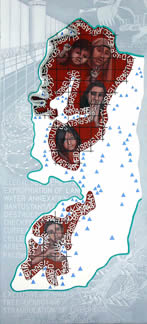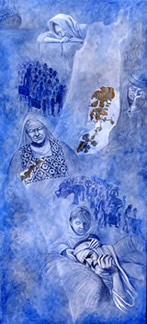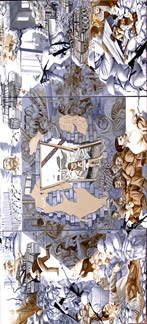|
DORA McPHEE
CV Born Melbourne, 1953
Education
1972-6 Bachelor of Science (Hons), Monash University, Australia
1982 Tertiary Orientation Programme – Fine Art, Prahran College of TAFE
1983-5 Bachelor of Fine Arts, Victoria College, Prahran Campus, Australia
1986-7 Graduate Diploma in Fine Art, Victoria College of the Arts, Australia
1986 Anatomy, Continuing Education, Melbourne University
1987-90 Bachelor of Arts, Melbourne University - discontinued
Solo Exhibitions
1988 Dante’s Inferno, George Paton Gallery, The University of Melbourne
1992 Three Phaedras, Judith Pugh Gallery, Fitzroy
1996 Permutations and Combinations, Temple Studio, Prahran
1999 Inspired by Rilke, Temple Studio, Prahran
2002 Silent Fragments, Art at Mount Macedon, Judith Pugh Gallery
2003 Flotsam & Jetsam, Art at Mount Macedon, Judith Pugh Gallery
Group exhibitions
1985 Women 150, Linden
Image and Voice, St Martins Theatre
1987 What is this thing called Science?, Melbourne University Gallery
MIRABILIS : Post-Appropriation, travelling show
curated by Juliana Engberg: Chameleon Gallery, Hobart;
George Paton Gallery, Melbourne; MOCA, Brisbane
1988 Vasari Revisited : A Kunstkammer in Melbourne, 200 Gertrude Street
VCA Postgraduate Exhibition, Melbourne University Gallery
1989 Ou est la femme?, George Paton Gallery
1990 Orphic Myths, Judith Pugh Gallery, Fitzroy
2nd Australian Contemporary Art Fair, Exhibition Building
1991 Family Fictions/Card Game, Judith Pugh Gallery, Fitzroy
1992 The Nude 1992,. Heide Gallery
1993 Seeing Rilke, Caufield Arts Complex
2004 Palestine Lost, Melbourne Town Hall
2005 Palestine Lost, Adelaide Town Hall
2007 Disappearing Palestine, State Library of Victoria
2008 Exhibition of Remembrance, Fitzroy Town Hall
Publications:
James Button : Art makes science its subject, The Age, Nov,1987
Naomi Cass : What is this thing called Science?, Melbourne University Gallery catalogue, Nov 1987
Juliana Engberg : Miriabilis : Post Appropriation, George Paton Gallery catalogue,1987
Brenda Ludeman : The Claim of the Laureate, George Paton Gallery catalogue,1988
Harriet Edquist : Dora McPhee: "Dante's Inferno", Agenda, Issue 1, Volume 1, June 1988
Fergus Armstrong Vasari Revisited, A Kunstkammer in Melbourne,Tension 16,1988
Juliana Engberg: Ou est la femme?, George Paton Gallery catalogue,1987
Christopher Heathcote : Like love, in Melbourne art will find a way, The Age, Feb, 1992
Neville Drury (ed) : New Art Six, Craftsman House, NSW,1992
Anna Clabburn : The Nude 1992, Heide Gallery catalogue, Nov-Dec,1992

WAITING FOR JUSTICE
DISAPPEARING PALESTINE
PALESTINE LOST
DISPOSSESSION - PARTS OF A WHOLE
|
Seven Panels of Collage
“Dispossession – Parts of a Whole”
The following seven panels of collage depict the dispossession and struggle of the Palestinian people through symbolic and photographic images. Each panel is presented as parts of a whole, and viewed together, they tell the story of the cumulative disintegration of Palestinian society under the crushing weight of occupation. Yet, despite all attempts to diminish them as a people, the Palestinians have maintained their dignity and strength of purpose. From the very rubble come the stones of resistance because that is all that they have to fight their oppressors. The Palestinians will not be silenced. Their voices are gradually gaining momentum as more and more people world-wide acknowledge the injustice of a people denied the land of their birth and their heritage. Against the tyranny of fabricated lies, truth will prevail and with justice will come peace. The Star of Bethlehem flower is the recurring symbol of that peace as well as symbolising the unrelenting struggle of the Palestinian people against the mighty forces of pen and gun.
The panels are a Women for Palestine initiative and concept, and these ideas have been powerfully expressed in the composition and application of gathered material by Melbourne artist Ms Dora McPhee. Without Ms McPhee’s fine sense of artistry, the material would never have had the arresting visual impact that such a story demands. Ms McPhee put aside work on her own series of paintings, which is the medium through which she is known, to embark on what she described as “art on demand”. It was a relentless exercise over a period of two weeks, working long days and well into the nights. We hope that the panels will capture your imagination and immerse you in the incredible sequence of events spanning well over half a century and leading to a situation that can only ever be resolved if the people of the world finally speak out against this terrible injustice after years of silence.
|
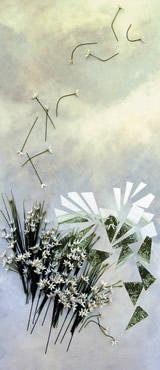 |
PANEL I
Flowers without Fields
This panel symbolically shows what once was in Palestine and the beginnings of disintegration and dispersal. The fragmented picture is a scene of the fields of Bethlehem in springtime before 1935. Once green and fertile fields covered with the Star of Bethlehem flower are no longer scenes of rural delight. Instead, the flowers have been cut from their roots and have been left to disperse like the people of Palestine. However, the flowers don’t disperse easily because there are so many of them and neither do the people. What is not shown is the horror yet to come. In effect, this panel depicts the calm before the storm and symbolises the peaceful land to which Palestinians everywhere ache to return. |
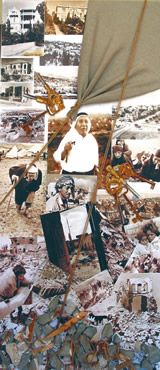 |
PANEL II
Keys without Locks
The man-made storm has come with a vengeance and has left nothing but rubble, utter destruction and a traumatised people. As hundreds and thousands of Palestinians flee for their lives, family homes, historic towns and ancient villages are occupied by Jewish settlers from post-war Europe or else razed to the ground. The tent is the refugee shelter – once temporary and now a permanent symbol of housing for refugees in exile. The keys portray those still carried by Palestinians who believe that they will one day be able to unlock the doors of their former homes now occupied without leave by strangers. And while the argument continues that the Palestinians sold or voluntarily left their homes and land, it is inconceivable that of a 700,000 population, every homeowner and landholder would have acquiesced in selling their homes - or more significantly their homeland - at any price in order to live in permanent exile. A lone flower spouting through the rubble is dwarfed by the sheer scale of destruction yet is a plaintive symbol of hope for a return to the lush fields and peaceful land of pre-1948 Palestine. |
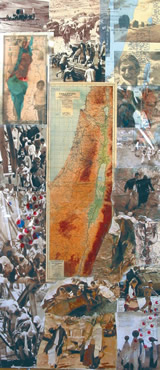 |
PANEL III
People without Land
This panel shows the movement of people against the permanence of an ancient land. It depicts the flight of the Palestinian people in 1948 as Zionist forces mount their attack and then again in 1967. Those who remain are effectively prisoners in the West Bank and the Gaza Strip – territories allocated to the Palestinians in the Partition Plan of 1947. However, even these territories are overwhelmingly populated by foreign settlers - Jewish immigrants from Europe, America and Africa who are being encouraged and financially assisted to settle in a land denied to the original inhabitants. A copy of a rare map signed by Moshe Dayan clearly shows that Palestine, in fact, was recognised in cartography contrary to assertions by Zionists that it never existed as a land under that name. The horror, disbelief, anguish and despair of a people dispossessed of their land are etched beneath transparent and shifting maps. Despite the will and might of foreign forces, the spirits of a wronged people continue to haunt this troubled land. |
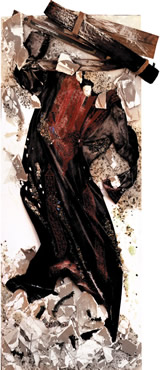 |
PANEL IV
Stitches without Meaning
As homes are bulldozed and destroyed, so too are the traditions of centuries. The meaning system of Palestinian embroidery which once identified people from each region, village and town and indicated the status of the person, is buried in the rubble. What was once handed down from generation to generation with pride has been torn apart with the disintegration of Palestinian society which existed for centuries before 1948. Now the language of the art struggles to survive in the refugee workshops where women painstakingly execute remnants of former patterns for sale to support their families. Today, the patterns worn by the women, increasingly reflect the Palestinian intifada rather than the heritage of their origins and so the meanings of the stitches so important to their culture is in danger of disappearing forever. |
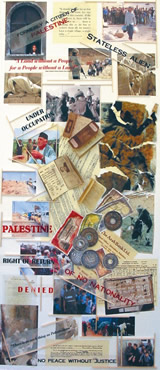 |
PANEL V
Documents without Rights
‘There is no such thing as Palestinians” were Golda Meier’s words in 1960 - words meant to negate the existence of a whole people, their identity and heritage. But, official documents and papers, old passports, identity cards and former currency, give the lie to these false words. The Palestinians were not nomads wandering in from the desert to a terra nullius. They formed a properly functioning society – certainly for 400 years under the rule of the Ottoman Empire and then during the British Mandate – but nevertheless, a Palestinian society with political and economic structures and an enormously rich cultural heritage. There were schools, universities, hospitals, governments departments, businesses and banks. The documents many still carry from before 1948, are testament to the nationality they had and what overnight was suddenly not recognised. Today, their identity cards are scrutinised at every Israeli checkpoint and they must suffer the humiliation of interminable queues and being regarded as aliens in their own land. The rights once afforded them by documents they still carry are now invalid with the stroke of a foreign pen. In effect, they are prisoners both inside and outside their land, powerless against the political machinations of those who refuse to recognise the inalienable rights of the Palestinian people in and to their own land. |
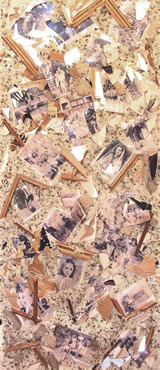 |
PANEL VI
Pictures without Frames
Photographs are permanent memories and for many it is all they have left as proof of their past lives in Palestine. This panel attempts to capture the human faces and special moments in the lives of Palestinians who have the same dreams and hopes as all people everywhere, but instead, those hopes and dreams and memories have been smashed and ground into the rubble of wanton destruction. Shards of mirrors reflect fleeting glimpses of all who look on, a reminder that we are no different to the humanity staring out at us from a now shattered past. Those pictures, once framed, marked the milestones in the lives of men, women and children who went to school, played sport, studied at university, and got married. Those pictures captured the moments of celebration and gladdened the hearts of loved ones. They were displayed, like yours and mine, on mantelpieces and tables or hung on walls - records of lives, of lives interrupted and lost. Some pictures are preserved in the meagre belongings of those Palestinians who fled the falling bombs and advancing forces, but others have had no chance of saving even themselves against the invading tanks. And so, the frameless pictures lie unclaimed, yet still a testament to the lives once lived in Palestine. |
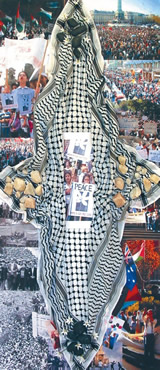 |
PANEL VII
Protests without End
After 60 years of occupation, disenfranchisement, oppression, vilification, wanton destruction and displacement, the voices of the Palestinian people have not bee stilled. Instead they are raised even more strongly today than in those early years when few could believe that not only their country, but the very word Palestine would be systematically and deliberately erased from the pages of history. The shock waves running through the one and a half million Palestinian population when the Partition was announced in 1947, is finally gathering momentum. Protests are resonating around the world to end the oppressive and brutal occupation of the Palestinian people, despite attempts to portray them as troublemakers and terrorists. The stone in a bloodied hand is their only weapon against far more powerful forces. This time the Hebrew story of David and Goliath plays itself out again in a reversal of roles - Palestine as David and Goliath as Israel and the Western world. This panel, against a backdrop of protests, depicts the symbols of the Palestinian struggle – the stones, the flag and the black and white keffiyeh. And, amidst the stones, the Star of Bethlehem flower is seen emerging – a sign that hope and the quest for peace are never entirely eradicated from the human condition. Perhaps a free and recognised Palestine is not such an impossible dream after all. |
Epilogue
What sort of society can consider itself civilized if it subjects the original inhabitants and civilians of the land they have occupied to years of oppression, humiliation and, now, wholesale destruction? What sort of despair and hopelessness has driven a civilized people to suicide bombings in retaliation? This is the status quo of the Israelis on the one hand and the Palestinians on the other. If we do not find a solution that brings justice to one people and allows another to have their state, we are living in a sad world indeed. Peace with dignity and humanity is the answer, but it will never be achieved if the world powers dictate the terms of peace according to their own interests. It is in the hands of people everywhere to put pressure on those who seek to act in our name and demand an end to all crimes against humanity. |
|




